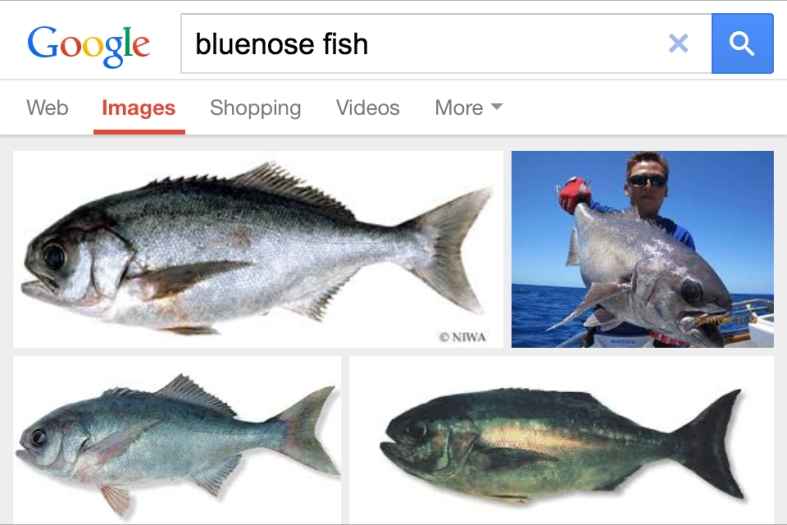“And also tonight we have bluenose.”
The name caught my ear. I had never heard of such a fish. Yet here was the chef listing it as part of today’s specials, to the sushi bar patron to the right of me.
Time to google. The cell signal was poor in this elegantly refitted, brick-walled building, and the photos loaded slowly.
I held up the phone. “Sensei, is this the fish?”

The Google.
“Yeah, looks like that!”
Bluenose, the Google explained, referred to Hyperoglyphe antarctica, which is being marketed as “bluenose sea bass” (ah, sea bass, that pesky catch-all term again) or “Antarctic butterfish”, while FishBase listed its United Nations records name as “bluenose warehou”.
“In Japanese, we call it me-dai. We got this from Kyushu.”
Kyushu is the third largest island of Japan, located to the nation’s southwest, and close to the Korean Peninsula. Kyushu city names that might be familiar to American ears include Kumamoto—source of the famed oyster species—and Nagasaki—site of the second atomic attack in human history.
But the Kyushu location threw my original identification in doubt. The listed localities for “bluenose” are in the Southern Hemisphere, in the seas off of South America, southern Africa, Australia, and New Zealand.
So when eating Japanese, speak as the Japanese. Another Google search—this time including the Japanese name, medai—turned up the correct identity for the sashimi now presented before me.
Medai is the Japanese name for Hyperoglyphe japonica, a very close relative of the bluenose—and as you can see, they are very similar in appearance. Medai, however, are only found in the seas around Japan.
The words medai is written in kanji characters as 目鯛, with “me-” (目) meaning “eye” and “-dai” (鯛) being the term in Japanese for snappers and porgies, but also as a general term for other similarly shaped fish (see previous stories on ishidai and onaga-dai).
“Eye” of course is referring to the large, round, doll-like eyes of this sleek but otherwise generic-looking fish:

The name “medai” refers to the relatively large eyes of the species, Hyperoglyphe japonica. Image Source: pomkn.cocolog-nifty.com
Taxonomically, medai and bluenose are not snappers nor porgies, but their generic-looking bodies belie some pretty strange things about the group they do belong to.
Medai and bluenose belong to the Family Centrolophidae–known as the medusafishes and barrelfishes in English. They’re called this because as young fish, many species hide under drifting seaweed or floating debris like barrels—while other species live among the bells and tentacles of jellyfish (or “medusa” as they are called classically, as if jellyfish were the mythical medusa’s head of deadly hair, drifting about the sea without a body).
And so these baby fish float out in the open sea, growing up in these mobile nurseries, feeding on different critters in the debris. The juveniles have cartoonishly large, snub-nosed heads, until they grow larger and stretch out into more “fishy” shapes, at which time they swim down to deeper waters to live. Medai can grow to 3 feet (90 cm) and are found around in depths of 500 feet (150m) or more.
As adults, medai do retain that snub-nosed look—a look that unites a broader group of fishes they belong to, the Stromateoidei. Ichthyologist Richard L. Haedrich, in his 1967 review of this odd taxonomic group, writes with a wink about their shared facial bone structure:
There is no mistaking the “stromateoid look”…once recognized, the stromateoid expression is not likely to be forgotten. It is a fat-nosed, wide-eyed, stuffed up look, smug and at the same time apprehensive. Some stromateoids might even be accused of a certain prissiness.
Haedrich’s review (which, for you fish geeks out there, is a great piece of natural history writing) mentions the other characteristic uniting this taxonomic group: they all have a “pharyngeal sac” in the back of their throat.
Imagine if you had a little fleshy sac in the back of your throat, filled with soft teeth like a cat’s tongue, which chewed up your food a little before you swallowed it. That’s what all these stromatoid fishes have, to different extents: medai have less toothy sacs, while other stromateoids have more complexly toothed sacs (Doiuchi and Nakabo 2006).
What was this sac originally evolved for? This appears to still be an unanswered question, since the diet of stromateoid fishes are not well known. Ironically, jellyfish might also be the answer here. Haedrich speculates:
Shelter is not all the jellyfish provide. Many stromateoids have been observed actively feeding on their hosts…the diagnostic pharyngeal sacs of stromateoids may have been perfected partially in response to this sort of diet.
As in somehow, this pre-chewing process facilitates digestion of jellyfish tissue, as one presumes that the gelatinous and often toxin-injecting tissue of jellies might be a little hard on a stomach, unprocessed.
Speaking of chewing, I’ve probably fed you more science than you can digest in one sitting. I certainly learned a lot from this happenstance introduction to a new species, let alone getting into all the strange details of a whole group of fishes. Of course, I also enjoyed tasting medai sashimi for the first time—it has a delicate but firmly muscled texture like that of snapper and other tai, but has a more buttery, sweeter taste more akin to hamachi and other fishes of the jack family (in fact, medai is sometimes passed off as higher-priced species like hamachi by dishonest merchants; see Iguchi et al. 2012).
Now let’s go catch some medai.

Hyperoglphe japonica, the Pacific barrelfish or medai. Image Credit: Ben Young Landis/CC-BY)
Hyperoglyphe japonica (Döderlein, 1884)
Medai
Click for names in other languages (FishBase)
Class Actinopterygii (Ray-finned Fishes)
Order Perciformes (Perch-like Fishes)
Family Centrolophidae (Medusafishes and Barrelfishes)
FishBase Page: http://www.fishbase.org/summary/13043
Citations
— Ben Young Landis



Nice info.thank you